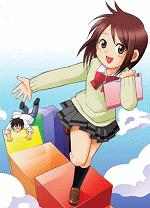Manga Guides to Statistics and Databases
By Murray Bourne, 25 Feb 2009
 This is an interesting series of books, available from www.edumanga.me:
This is an interesting series of books, available from www.edumanga.me:
- The Manga Guide to Statistics
- The Manga Guide to Calculus
- The Manga Guide to Physics - Dynamics
- The Manga Guide to Molecular Biology
- The Manga Guide to Databases
Each chapter in the books has the following format:
- Cartoon
- Text explanation to supplement the cartoon
- Exercises and answers
- Summary
For those of you who are not sure, "manga" is the name given to Japanese comics and cartoons. They are massively popular in Japan and are read by all ages.
My first question about this series of manga-based educational books concerns the market. Who would buy these? I can't imagine too many math teachers assigning them for classroom texts (they don't look "serious" enough) and students will tend to read "real" manga rather than these. The only niche left are the math teachers.
When I started to read The Manga Guide to Databases, I felt the first few pages were quite childish.
However, once I got up to the explanation part I felt that the message had got through. The exercises and answers are textbook-like, but have appropriate difficulty. The summary at the end of the chapter presented the information for the fourth time, and it was quite effective.
Moving on to the second chapter was an interesting experience — it was relaxing to get back to the (manga) story. When you compare this to most textbooks where going on to the next chapter means harder and more complicated stuff, it appears that the manga series has hit on a winning formula.
By the end of the book, I felt the main concepts had been presented quite well.
The Manga Guide to Statistics has more of an "edge" than the database book. The characters are stronger and the artwork is racier. When things start to get a bit confusing, the characters in the story openly complain about how hard it is. This empathy for how students feel is a strong feature of these books.
The series is translated from the original Japanese.
These books are certainly worth a closer look and should be considered for use as "real" text books. They could always be supplemented with other exercises for more depth, but they are certainly more interesting than most text books.
See the 5 Comments below.
